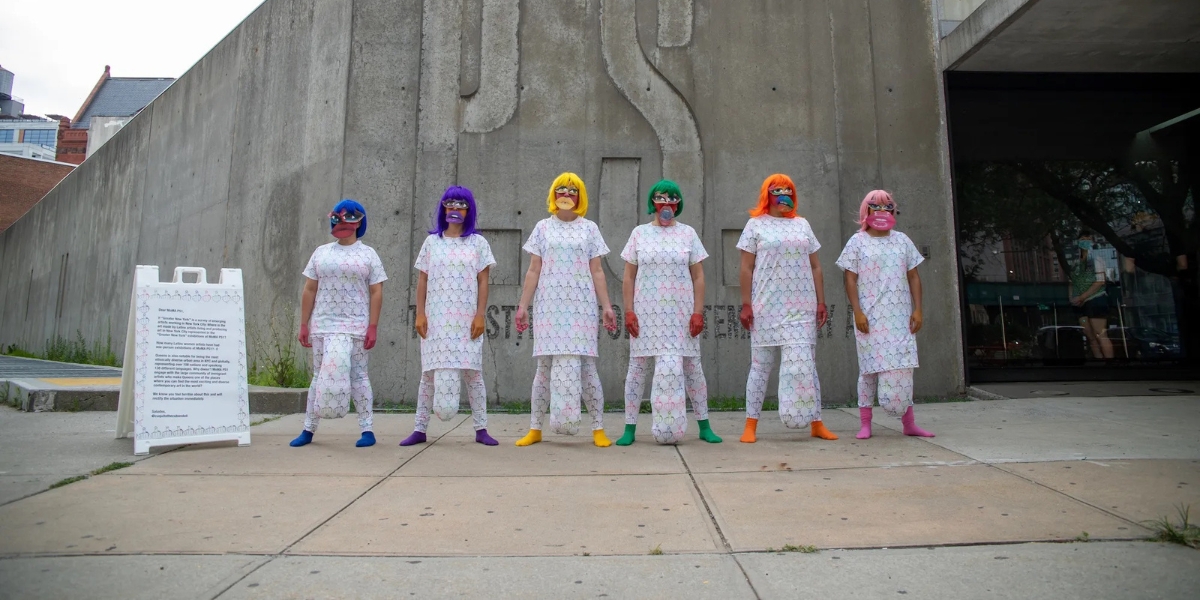This is the second segment in a series highlighting Latina artists like Yali Romagoza, the uphill battles we face, and the ways we’re counteracting our own erasure.
I first heard about Yali Romagoza in 2021, though she’s been working in the United States since 2010 and in Cuba since 2007. It was also the first time Hyperallergic had featured her. Let that sink in. An artist whose work is visceral, unapologetic, and deeply engaged in the politics of visibility – yet it took years for even an independent art publication to cover her. The piece? A report on Romagoza’s unannounced, performative protest outside MoMA PS1, calling attention to the museum’s abysmal record of solo exhibitions for Latinx women artists.
That’s how Latina artists get attention: not by waiting for the art world’s blessing, but by disrupting it.
Uninvited but Impossible to Ignore
Yali Romagoza isn’t just making art – she’s making people uncomfortable, and that’s precisely the point. The Cuban-born, New York-based artist doesn’t ask for permission. Through performance, costume, and installation, she inserts herself into spaces that would rather keep her out. Whether she’s wrapped in an oversized, self-made garment resembling a colonial relic or performing a ritualistic action that forces spectators to reckon with their own gaze, she embodies what it means to be hyper-visible yet invisible in the art world.
It’s no accident that Romagoza staged her performance outside MoMA PS1. Latinx women artists are statistically irrelevant in the museum’s history. Ask yourself: how many solo shows have they had at MoMA PS1? If you guessed more than two, you’d be wrong.
That’s not a gap – that’s erasure. And Romagoza knows it.
The Press’s Selective Attention
Romagoza’s work is not subtle, so why does it take an unannounced protest for the press to care? Why does a Latina artist have to quite literally put her body on the line, outside a major institution, in the middle of the street, disrupting the flow of business as usual, just to get a headline? We’ve seen this cycle before. Latina artists don’t get coverage unless they’re causing a scene – or dead. And even then, the attention often comes with a caveat: was she a radical? Was her work digestible enough for mainstream audiences? Was she already vetted by the right institutions?
Meanwhile, the same five white male painters get endless breathless profiles, their slightest artistic pivots treated as seismic shifts in contemporary art. We read about their childhood influences, their studio rituals, their deeply intellectual struggles with color and form. But Latina artists? They get the occasional nod when someone decides it’s finally time for a diversity feature, when a curator remembers that, oh right, representation matters. And even then, it’s rarely a deep dive into their practice – it’s a bullet point in a broader conversation about inclusion.
The truth is, media outlets are complicit in maintaining the art world’s status quo. What happens when you never read about Latina artists? You don’t even know we’re here. And when an artist like Romagoza forces her way into the frame, it seems like an anomaly instead of the norm it actually is. She becomes an exception, a curiosity, a token – rather than an artist whose work demands the same level of engagement as her white male counterparts. The art world thrives on narratives of discovery, of “finding” new talent, but when that discovery conveniently excludes entire demographics, it’s not an accident. It’s a choice.
The Burden of Visibility
Latina artists are expected to be our own advocates, publicists, and institutions because the existing ones won’t do it for us. Romagoza’s career – like so many others – has been shaped by this constant battle for recognition. What does it say about the art world when Latina artists have to stage their own interventions just to be acknowledged?
Romagoza’s forcing the industry to confront its own biases in real time. But here’s the uncomfortable truth: the art world loves its rebels only after it decides they’re marketable. It celebrates radicalism when it’s safely archived, when it can be packaged and sold, when the right collector or critic gives it their stamp of approval.
Until then? Artists like Romagoza exist in a frustrating limbo, recognized enough to be referenced, but not enough to be fully supported. So what exactly are we waiting for? For a major institution to give her a solo show? For a blue-chip gallery to sign her? For a retrospective twenty years too late? If the art world only acknowledges Latina artists after they’ve fought their own battles for visibility, then it’s not actually supporting them. It’s co-opting their struggle for profit.
Here’s the thing: Latina artists are not waiting for permission. We’re doing the work, making the art, demanding space. The question is: will the art world step up or will it keep pretending not to see us?
Supporting Latina artists isn’t just about applause – it’s about institutional change, media accountability, and a fundamental shift in who gets to be part of the narrative.
Because if the art world won’t invite Latina artists in, we’ll keep showing up anyway. And as Yali Romagoza has already proven, we’ll do it in style.
Image: “No me pongan en lo Oscuro (Do not Bury me in Darkness) Action #6”, unannounced performative action at MoMa PS1, New York, July 24th, 5:30 pm, 2021. Performers: Julia Justo, Ame Gla, Salome Egas, Veronica Pena, Gabriela Sanchez Frank, Yali Romagoza. (photo by Paola Martinez-Fiterre; courtesy of Yali Romagoza).

